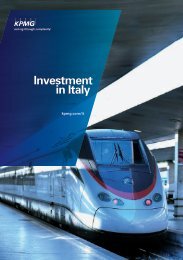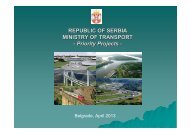Innovation Canada: A Call to Action
Innovation Canada: A Call to Action
Innovation Canada: A Call to Action
You also want an ePaper? Increase the reach of your titles
YUMPU automatically turns print PDFs into web optimized ePapers that Google loves.
<strong>Innovation</strong> <strong>Canada</strong>: A <strong>Call</strong> <strong>to</strong> <strong>Action</strong>every five years. Budget 2007 announced a newEMS that includes a requirement for spendingproposals <strong>to</strong> clearly define expected results, andfor departments <strong>to</strong> manage against these resultsand formally evaluate program performance(Department of Finance 2007). Budget 2007also introduced strategic reviews ofdepartmental expenditures on a four-year cycle<strong>to</strong> determine whether they are achieving theirintended results and are aligned with thegovernment’s priorities. Because these strategicreviews are Cabinet documents, their resultswere not available <strong>to</strong> the Panel. In Budget 2011,the government announced a strategic andoperating review that will assess $80 billion indirect program spending across the federalgovernment in order <strong>to</strong> achieve at least$4 billion in ongoing annual savings by2014–15 (Department of Finance 2011).Although this program evaluation machinery isuseful for management purposes, it does not,for reasons discussed below, enable assessmen<strong>to</strong>f which of the programs reviewed by the Panelare relatively more or less effective.Assessment of Program“Effectiveness”Effectiveness, as noted earlier, is defined by theTreasury Board Secretariat as simply “the extent<strong>to</strong> which a program is achieving expectedoutcomes.” Based on the Panel’s assessment ofprograms, it is clear that individual programs’“expected outcomes” are as varied as theprograms themselves, and <strong>to</strong> a large extent areincommensurable. For example, the ScientificResearch and Experimental Development(SR&ED) program, because it is deliveredthrough the tax system, does not have a resultsbasedaccountability framework and itsperformance is not evaluated on a regular basis.However, the Department of Finance hasoccasionally undertaken economic assessmentsof the program from a net benefit perspective— that is, estimating the economy-widebenefits and netting out the estimated costs ofadministration, compliance and the impositionof taxes (for the most recent assessment, seeParsons and Phillips 2007). Work undertaken forthis review applied the net public benefitmethodology <strong>to</strong> a sample of other programsbut, for reasons outlined in Chapter 6, the Panelhas concluded that the method is notsufficiently precise and well developed at thisstage for general use <strong>to</strong> assess the comparativeeffectiveness of programs.The more sec<strong>to</strong>r-focussed programs, such as theSD Tech Fund and FP<strong>Innovation</strong>s, have intendedfinal outcomes that are relatively narrow in scope— for example, increased market growth, sec<strong>to</strong>rcompetitiveness and specific environmentalbenefits. On the other hand, many programsinclude outcome objectives at the scale of theentire economy — for example, productivitygrowth or the overall prosperity of Canadians.Such ultimate impacts of individual programs areeffectively impossible <strong>to</strong> measure, since thespecific contribution of the program in questioncan rarely be isolated from the myriad fac<strong>to</strong>rsthat affect all macroeconomic outcomes.Intermediate outcomes, which occur closer <strong>to</strong> aprogram’s point of influence, are obviously easier<strong>to</strong> measure and attribution is stronger, althoughalmost never definitive. The Panel has observedthat intermediate outcomes are typicallyidentified according <strong>to</strong> each program’s specificobjectives. Internship programs, for example,have as desired outcomes increased jobopportunities in the business sec<strong>to</strong>r forgraduates. Other programs seek <strong>to</strong> increasepartnerships and collaboration, establishnetworks, foster an entrepreneurial culture,develop and retain researchers in <strong>Canada</strong>, oradvance the commercialization of new products5-2
















